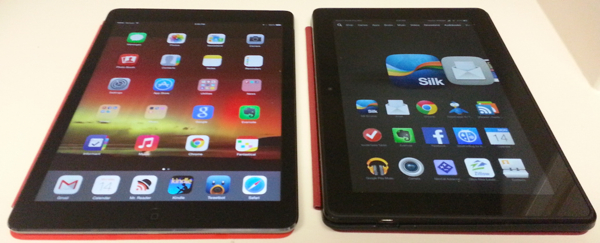Get a new tablet for work, check your data usage

Getting a new mobile device is an exciting event for those of us addicted to tech. That's especially true for gadgets we get to use for work. When that shiny new toy has 4G baked in, we don't usually think how that may affect our data usage. What I'm seeing is it can indeed impact usage, and not always in a good way.
I made two recent purchases that have 4G capability. I swapped an iPad 4 for an iPad Air last November, and last month I ditched an iPad mini in favor of the Kindle Fire HDX 8.9. Both the iPad Air and the Kindle have 4G, as did the two tablets they replaced.
See also: Check your data usage: You might be paying for too much | Verizon offers buckets of data with the Share Everything plan
Most work days I use the iPad Air or the Kindle Fire HDX all day. I usually have 4G enabled for at least two hours a day, as I often see spotty wi-fi in the public venues I frequent. I no longer worry about exceeding my 10GB data cap since the analysis I did a year ago pointed out I don't come close to hitting my data ceiling. You're as likely to see me on 4G as on wi-fi.
I frequently use one of the 4G tablets as mobile hotspots for wi-fi laptops I use, and also in my home office when my ISP service gets erratic. Office sessions can last all day on 4G using the tablet hotspot.
Since discovering how little data I use monthly, I regularly check with Verizon to see how my usage varies. I track it to see how changes in my routine affect the amount of data I use.
The chart above is the most recent analysis, and it points out how changing devices impacts my data usage. The first change in my routine indicated by the red arrow is the exchange of the iPad 4 for the iPad Air. My monthly data usage of over three GB dropped significantly with the new iPad Air.
Featured
This is not a scientific analysis by any means, and it's not a controlled experiment. This is strictly an observational exercise based on my actual data usage figures from Verizon.
While the iPad exchange may not alone be responsible for the drastic drop in data usage, it must bear some responsibility. I use the iPad Air as heavily as I used the iPad 4 it replaced, and it is the major consumer of data in the period after it came online. It makes me wonder if the iPad Air somehow handles 4G communications better than its predecessor. I know my work routine did not change significantly enough to cause the big drop in 4G consumption.
The second device change reflected on the chart above was trading the iPad mini for the Kindle Fire HDX. That happened at the point on the timeline indicated by the purple arrow. Contrary to the change with the iPad Air, data consumption jumped when the Kindle Fire HDX came online.
After just over a month with the Kindle Fire HDX, 4G usage has almost doubled. This bears watching as time progresses to see if a sustained pattern results from using the Kindle.
Again, this is not a scientific analysis at all. It is interesting, however, how the two device changes immediately resulted in differences in data consumption. It points out that perhaps a device can greatly impact data usage compared to a similar device, and that bears watching. This is especially true for those of us getting a new device with 4G for work purposes. We don't want to get caught with our data caps down.
I use 4G connectivity heavily, and it still amazes me how little data I use monthly. Granted I don't stream video a lot, just the occasional YouTube video. I still have hours of online activity daily, yet the total data usage is lower than you might think.
